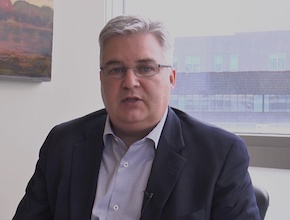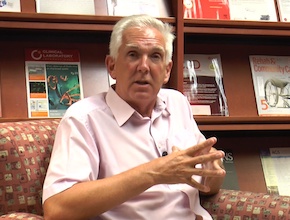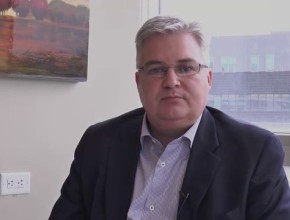Related McMaster Perspective episodes
McIvor A, Jaeschke R. Use of inhaled medications in COPD.References
Wedzicha JA, Banerji D, Chapman KR, et al; FLAME Investigators. Indacaterol-Glycopyrronium versus Salmeterol-Fluticasone for COPD. N Engl J Med. 2016 Jun 9;374(23):2222-34. doi: 10.1056/NEJMoa1516385. Epub 2016 May 15. PubMed PMID: 27181606.Vogelmeier C, Hederer B, Glaab T, et al; POET-COPD Investigators. Tiotropium versus salmeterol for the prevention of exacerbations of COPD. N Engl J Med. 2011 Mar 24;364(12):1093-1103. doi: 10.1056/NEJMoa1008378. PubMed PMID: 21428765.
Roman Jaeschke: Thank you for this [see: Use of inhaled medications in COPD]. You were talking in general terms about long-acting muscarinic antagonists (LAMAs) and long-acting ß2-agonists (LABAs). There is an increasing choice of those specific preparations. Is there any difference among them? Is there anything you would advise people? How to choose them? Or it does not matter?
Andrew McIvor: There are a lot of new chronic obstructive pulmonary disease (COPD) medications available on the market. There are no direct head-to-head comparisons between one company’s inhaler and other company’s inhaler in the same class. Sometimes the individual’s choice may be related to the frequency: some of these medications are once or twice a day; sometimes it may be related to the activity: some have a rapid onset and an ultra-long duration of action, meaning they last full 24 hours, some are only long-acting and only last 12 hours. Also it may be the individual device as well: some of the devices are multiload, some of them require an individual capsule to be inserted each day. Going back to our introduction to pharmacology, we know the strengths and weaknesses of once a day versus twice or 3 or 4 times a day, single-load devices compared to multiload devices, combination inhalers versus separate, single-dose inhalers.
RJ: Thank you. What do you use?
AM: I think that the Global Initiative for Chronic Obstructive Lung Disease (GOLD) guidelines will have a significant update next year. In my personal practice, as I mentioned already, in all but the mildest patients I will start now with a LABA/LAMA combination drug. For office-based practice, if you do not have spirometry to confirm your COPD yet, I would start with whatever cheap, effective medication you use, either a LAMA in Canada or in some other countries I know the LABA medications may be a little bit less expensive. There is one old study called the Poet Study from the New England Journal of Medicine; I am sure that in fact if you have a choice between a LAMA and a LABA as monotherapy, the LAMA is maybe a little bit better, but again, for patients with established disease remaining symptomatic on single-agent therapy, my foundation treatment would be a LABA/LAMA combination drug. Then I may in the future consider addition of other treatment regimens, but that needs to come with a very, very succinct nonpharmacological regimen. Again, I mentioned a strong advice and assistance to stop smoking, improving exercise, normalization of weight, and routine flu vaccination and consideration for pneumococcal vaccine for your patients, plus or minus an exercise or a more formal pulmonary rehab program.
RJ: Thank you for all this. Now, the last question – and we might have started from it, actually. I knew that for years you were a proponent of maximum bronchodilation and use of muscarinic antagonists. I wonder if you could, for our listeners, summarize within a short time the study which led to our meeting.
AM: There has been a number of studies that have come out recently and shown the benefit of the LABA/LAMA combination class. But the recent study called the FLAME trial in the New England Journal of Medicine was a very, very interesting paper because what it really did was it compared a very commonly prescribed inhaled corticosteroid (ICS)/LABA preparation combining fluticasone and salmeterol for management of COPD patients with one of the new LABA/LAMA combination drugs combining indacaterol with glycopyrronium. And it showed the benefit of the LABA/LAMA in improving symptoms, improving quality of life, and actually also reducing exacerbations without having a steroid component. This gets back to what I mentioned earlier on: remember, steroids are not bronchodilators but people have been so entrenched in prescription of ICS/LABA in asthma and now in COPD that they sometimes have missed the comment that two bronchodilators actually cause better bronchodilatation than one bronchodilator and an inhaled steroid in a condition like COPD, which is not an eosinophilic obstructive lung disease. So again, I think [it is] very, very interesting information.
All good studies raise more questions than they answer, but this certainly gives me confidence for my patients. I tend to use the term “optimally bronchodilate”; sometimes when you say “maximally” people are worried it may be too strong or whatever, but these drugs seem to be very efficacious, very effective, well-tolerated, and as we have heard already there are a number of different preparations. The FLAME was with one of these, but all of the other medications in this class should have the same efficacy for the patients.RJ: We may decide to divide this interview in 2 parts, so I will still ask you a question then; it is likely separate. When you are choosing therapy for your patients and you are going for optimal bronchodilation, do you look for evidence that there is no reversibility in terms of potential use of corticosteroids, this overlap?
AM: This is one of the most controversial aspects of COPD management today. In fact, both GOLD and Global Initiative for Asthma (GINA) guidelines have come up with asthma-COPD overlap syndrome (ACOS) and I think we all really know what it is, the overlap between asthma and COPD. But just to remind you: if you see someone with very, very impaired lung function and forced expiratory volume in 1 second (FEV1) of maybe 20%, 0.8 L, and that goes up by 20%, it does not mean they have asthma. To me, asthma is an obstructive lung disease that has an allergic component that is variable, in which the lung function improves to normal or towards normal with treatment, and is responsive to oral or inhaled steroids. COPD is an obstructive lung disease that is partially reversible, so I still think – for those patients I find in my practice – it is easy to differentiate a lot of patients between asthma and COPD. Naturally, there are some patients in the center and I think what we do is we make our best assessment of those individuals. The crucial factor is if they do have an underlying allergic, asthmatic component, perhaps if they had symptoms of asthma as a kid, perhaps if their smoking history is not as high, maybe those patients are patients I still might treat with an asthma algorithm and have an ICS/LABA. But the vast majority of patients that I see that are in mid- to late-life, have significant smoking histories or exposure to environmental pollution with little underlying allergic component, do far better on a LABA/LAMA combination drug.
RJ: Last question, I promise. Safety of LABA and LAMA. There were intermittent concerns about both.
AM: Yes. I think that the various regulative authorities are very sensitive now to not only adverse events but also tolerability. The rigors that these medications have gone through are much higher than they would have 10, 20, or 30 years ago. I am very convinced of their safety – of these medications, of the currently prescribed dose, even despite some information we know that anticholinergics may have an issue with their cholinergic side effects. About the only time I am perturbed with this is when someone sees an eye doctor, has some problems, and they tell me not to use an anticholinergic, and then I might use a ß2-agonist. But patients we see in hospitals frequently require urinary catheters put in, et cetera, and I do not think it is because of systemic effects of an inhaled preparation. In general I feel, apart from rare circumstances, these drugs are extremely safe for patients.
RJ: Thank you very much. I hope it is all of some use for our listeners. Thank you.
AM: Thank you.
 English
English
 Español
Español
 українська
українська





